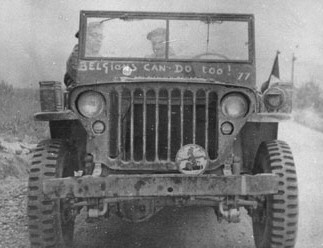

 |
 |
 |
For the three day battles in the "Broken Arrow" positions, the BUNC received
its second Republic of Korea Presidential Unit Citation and was mentioned in the Belgian
Army's Order of the Day on 25 June 1953. The latter citation, translated, reads :
Article two - The Fourragère is bestowed on the flag of the Volunteer Corps for Korea
that previously was mentioned in the Army's Order of the Day, by Decree No. 447 of 4
January 1952." Note : the fourragère mentioned above is the War Cross Fourragère (Croix de Guerre). |
 |
 |
The Haktang-Ni Battles (12 - 13 October 1951)

On 10 October, the battalion arrived and set up its positions and immediately enemy artillery fire was aimed at it. Occasional artillery and mortar fire would continue the whole night and the following day and enemy patrols that night were stopped by extensive use of hand grenades. During the night of 11-12 October, several small enemy attacks were again repulsed.
On 12 October, a patrol by B-company went up to the Palli Bong (Hill 488) and exchanged
a fire fight with its Chinese occupants. Artillery fire was directed at the enemy
positions who were observed to be disorganised by the attack. A patrol to the neighbouring
Hill 317 found an enemy ammo dump on the hill and destroyed it before returning to the
lines. As night fell, the Chinese were observed to occupy Hill 317 and all through the
night artillery fire would be directed on their positions there (a patrol the next day
would confirm the effectiveness of the artillery fire from abandoned and destroyed weapons
and traces of many wounded). No doubt this caused a serious delay of the Chinese attacks
on the battalion's positions which started at 23.30 h by a severe attack on the southern
part of the battalion's defences. The enemy managed to infiltrate between B-company and
ZW-company so that the latter was effectively cut off and attacked from all sides.
Sergeant Caudron directing the fire of flamethrowers of his pioneers section, defending an
outpost (10), and MG gunner Pvt.
Klausing were instrumental in repulsing these first attacks (11). Further attacks were launced
by the enemy and the company commander, Captain Dargent, personally manned an MG on top of
his command post to allow the pioneers section to withdraw within the company perimeter (9). Mortar and artillery fire aimed
directly in front of the company's positions helped stem the enemy attacks and by 01.00
these were diminishing. All this time, B and C-companies had been under mortar and machine
gun fire and now the enemy directed its attacks on those positions. A counterattack
fianlly chased the last of the
Early in the morning of 13 October a post was set up on Hill 317 and a platoon from C-company went on a reconnaissance patrol towards To Dong. Shortly after it fell under fire from the Chinese on Palli Bong, an order from 3rd Division was received to end the occupation of the Broken Arrow positions and to withdraw from this vulnerable outpost. Under cover of artillery fire and smoke screens, the battalion gradually withdrew unnoticed and savoured witnessing, from its new positions, a futile enemy artillery barrage and night assault on its former, now abandoned, lines.

 |
 |
| The BUNC was part of the US 15th Inf.Reg. at the time and readily adopted its own version of that regiment's "Can do"-motto. | |
Copyright Hendrik Meersschaert 2024 ©